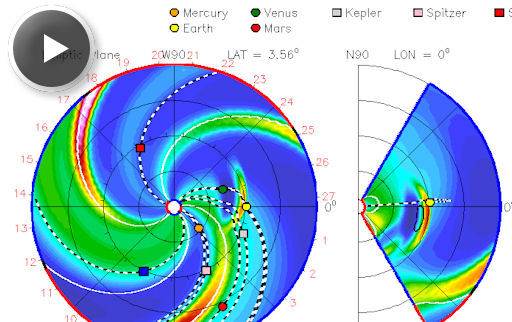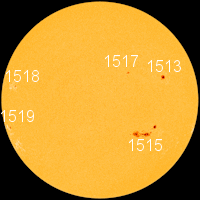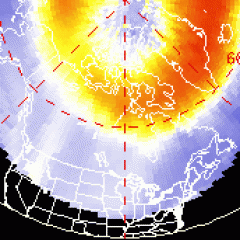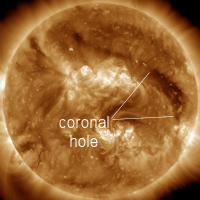Space Weather Update~ HIGH SOLAR ACTIVITY [1]
HIGH SOLAR ACTIVITY: Behemoth sunspot AR1515 is crackling with M-class solar flares and appears to be on the verge of producing an X-class [2] explosion. NOAA forecasters estimate an 80% chance of M-flares and a 10% chance of X-flares during the next 24 hours. X-flare alerts: text [3], voice [4].
INCOMING CME: On July 4th, sunspot AR1515 hurled at least four minor CMEs into space. Most flew south of the ecliptic plane (the orbital plane of the planets), on track to miss everything. One of them, however, appears to be heading toward Earth. Click to view an animated forecast track of the incoming cloud:
According to analysts at the Goddard Space Weather Lab, who prepared the forecast, the cloud will reach Earth on July 7th around 0600 UT. High-latitude sky watchers should be alert for auroras on that date. Aurora alerts: text [3], voice [4].
Realtime Space Weather Photo Gallery [6]
SOLAR STATIC: Sunspot AR1513 erupted on the 4th of July, producing an M2-class solar flare and a burst of shortwave radio noise that roared out of the loudspeakers of receivers on Earth. Amateur radio astronomer Thomas Ashcraft of New Mexico recorded the solar static at 21 MHz:
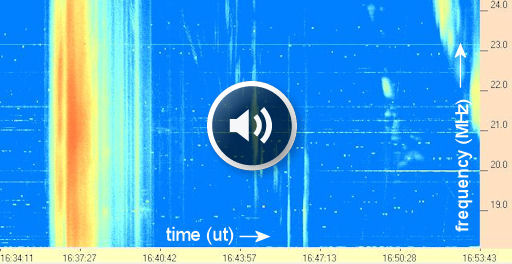 [7]
[7]
Dynamic spectrum courtesy of Wes Greenman, Alachua Radio Observatory, FL
"While waiting for a potential X-flare in AR1515, I captured this 'radio-active' M-flare in AR 1513," says Ashcraft. "The audio sample contains two types [8] of solar radio emission: The Type III solar bursting starts at 15 seconds and the Type V kicks in at around one minute or so."
These radio sounds are caused by beams of electrons [9] accelerated by the flare. As the electrons slice through the sun's atmosphere, they generate a ripple of plasma waves and radio emissions detectable on Earth 93 million miles away. More radio bursts are in the offing as AR1515 and AR1513 crackle with magnetic explosions. Ham radio operators, point your Yagis [10] toward the sun! X-flare alerts: text [3], voice [4].

![]()
Solar wind
speed: 457.3 km/sec
density: 2.5 protons/cm3
explanation [11] | more data [12]
Updated: Today at 2127 UT
![]()
X-ray Solar Flares
6-hr max: M1 2014 UT Jul05
24-hr: M6 1144 UT Jul05
explanation [13] | more data [14]
Updated: Today at: 2100 UT
![]()
![]()
![]()
Daily Sun: 05 Jul 12
![]()
![]()
Sunspot 1515 has a delta-class magnetic field that harbors energy for X-class [16] solar flares. Credit: SDO/HMI
![]()
![]()
![]()
Sunspot number: 129
What is the sunspot number? [17]
Updated 05 Jul 2012
Spotless Days
Current Stretch: 0 days
2012 total: 0 days (0%)
2011 total: 2 days (<1%)
2010 total: 51 days (14%)
2009 total: 260 days (71%)
Since 2004: 821 days
Typical Solar Min: 486 days
Updated 05 Jul 2012
The Radio Sun
10.7 cm flux: 163 sfu
explanation [18] | more data [19]
Updated 05 Jul 2012
![]()
![]()
![]()
Current Auroral Oval:
![]()
Switch to: Europe, USA, New Zealand, Antarctica
Credit: NOAA/POES
![]()
![]()
![]()
Planetary K-index
Now: Kp= 3 quiet
24-hr max: Kp= 4 unsettled
explanation [21] | more data [22]
![]()
Interplanetary Mag. Field
Btotal: 10.1 nT
Bz: 5.9 nT north
explanation [23] | more data [24]
Updated: Today at 2127 UT
![]()
![]()
![]()
Coronal Holes: 04 Jul 12
![]()
![]()
Earth is inside a stream of solar wind flowing from this coronal hole. Credit: SDO/AIA.
